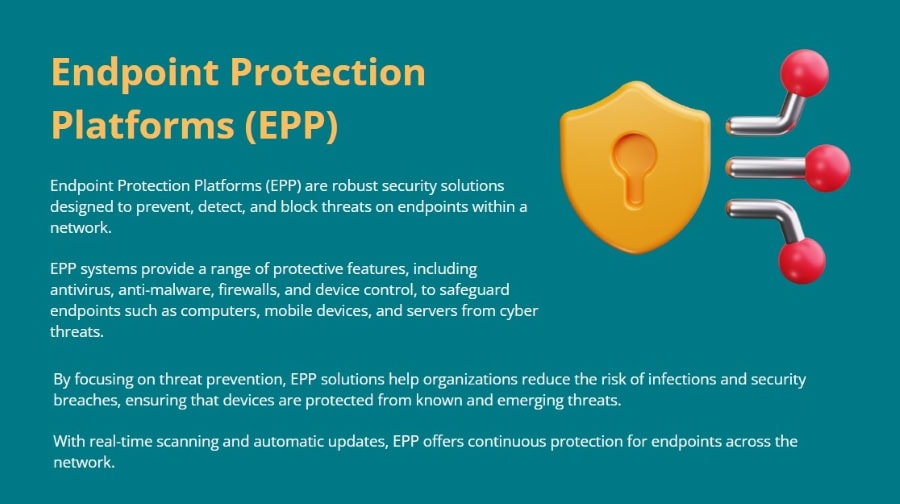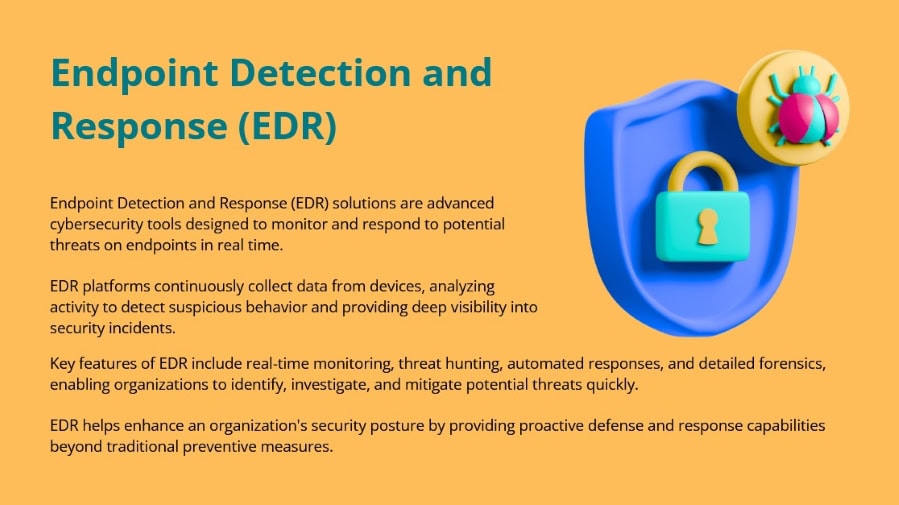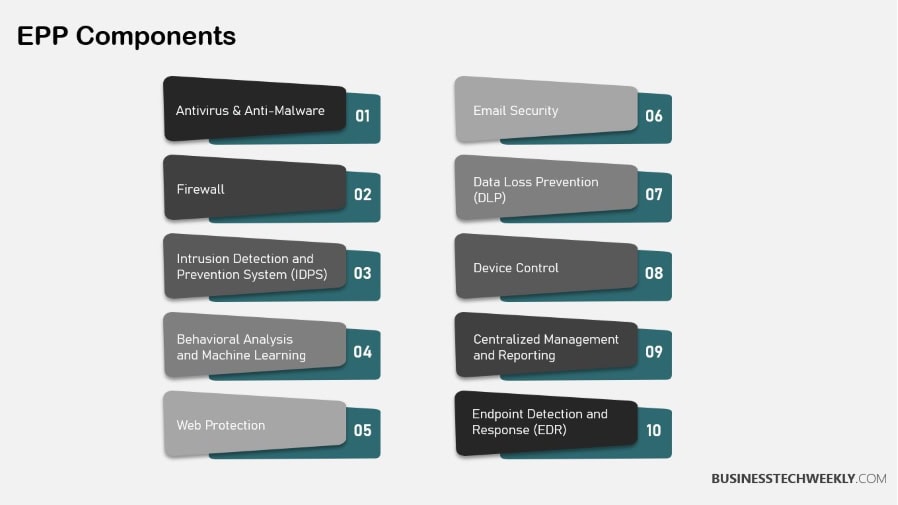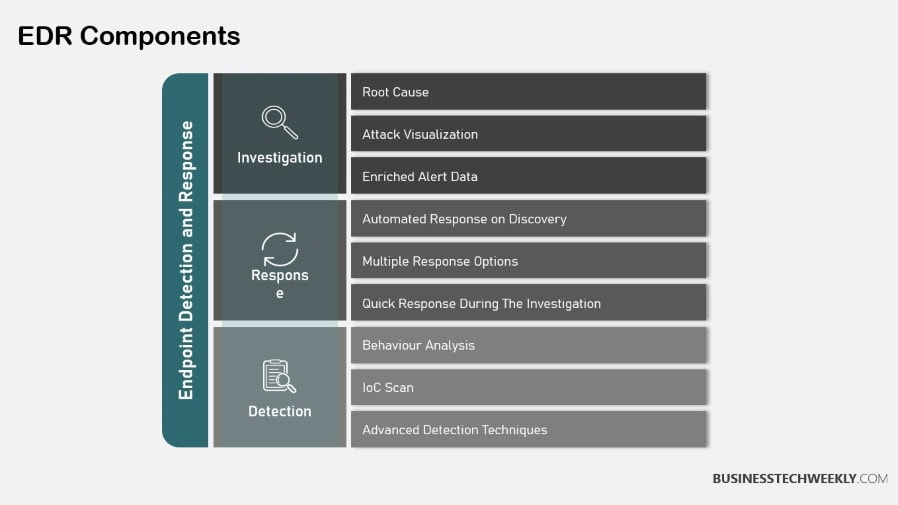EPP vs EDR: Which Solution Should You Choose?

When it comes to endpoint security, understanding the differences between EPP and EDR is crucial for businesses seeking effective protection. EPP vs EDR is a common debate in cybersecurity, with each offering distinct advantages in safeguarding devices.
When comparing EPP vs EDR, what is clear is that while EPP (Endpoint Protection Platform) focuses on preventing threats, EDR (Endpoint Detection and Response) provides advanced monitoring and response to emerging security incidents.
But is one solution truly better than the other?
In this article, we’ll explore the key differences between EPP and EDR, helping you decide which solution best fits your organization’s needs for comprehensive endpoint protection.
On this page:
What Is EPP?
EPP, or Endpoint Protection Platform, is a powerful cloud-based tool. It actively scans your devices for known suspicious code signatures. It’s more like a vigilant sentry that searches your computer or mobile device for anything suspicious.
This proactive approach nips security breaches in the bud by being focused on prevention. Think of it like adding another lock to your door. It creates a lot more work for malware and cyber threats to slip past.
EPP doesn’t just work in a vacuum. It complements your existing cyber defense plans and gives a solid boost to your overall security. It stays below the radar by providing passive protection but is still on the lookout and ready to spring into action at the first sign of trouble.
This means you don’t need to worry about your system dragging down with constant active tracking. Instead, EPP intervenes only after it detects something fishy.
Key Features of EPP
EPP crams in the most important features — such as antivirus, firewalls, and data encryption — to help secure your data. It employs allowlisting and blocklisting to determine which programs can run on your device.
It doesn’t require constant monitoring. It jumps in where necessary, using behavioral and static analysis to discover threats. Here’s a quick look at some EPP tools and what they offer:
- Antivirus: Scans and removes malicious software.
- Firewall: Blocks unauthorized access to your network.
- Data Encryption: Keeps your sensitive data safe from prying eyes.
- Allowlisting and Blocklisting: Control which applications can operate based on trust levels.
RELATED: 10 of the best antivirus software packages for business

EPP as a Preventive Measure
Prevention is better than cure, and EPP is all about stopping attacks before they start. It’s important for keeping your devices safe from known threats such as malware and ransomware.
With EPP, you enjoy peace of mind knowing your endpoints are secure. Consider it a digital shield against any cyber arrows that may be thrown your way. If a vulnerability is ever found, EPP springs into action.
It blocks the threat and keeps your systems running along just fine.
Essential Functions of EPP
EPP serves many key functions, like threat detection, response, and compliance monitoring. It also plays a key role in your general cybersecurity setup, protecting your enterprise’s endpoints.
EPP integrates with other security technologies for all-around protection, ensuring that no stone is left unturned. Here’s a list of what EPP can do for you:
- Threat Detection: Identifies and alerts you to potential threats.
- Response Capabilities: Takes action to mitigate any detected threats.
- Compliance Monitoring: Ensures your systems meet necessary security standards.
RELATED: Threat Detection and Response: Best Practices
What Is EDR?
EDR, or Endpoint Detection and Response, is a security solution focused on continuous monitoring and proactive threat remediation.
EDR goes on the lookout for those tricky attacks that classic security measures, such as firewalls, tend to overlook. It’s designed to catch all the sophisticated threats that fall through the gaps.
EDR offers on-device real-time insights into activity. This allows you to respond to threats properly and strengthens your cybersecurity strategy as a whole.
Key Features of EDR
EDR includes a host of useful features. It constantly monitors your systems and applies AI-based analysis to detect anomalous behavior.
Additionally, EDR can sandbox suspicious code, keeping the code isolated for closer inspection without jeopardizing your entire network.
It also helps you stay compliant by monitoring all your security measures. You receive detailed insights about any threats it finds, enhancing your overall security posture.
For a quick comparison, here’s a table of EDR vs. EPP features:
|
Feature |
EDR |
EPP |
|---|---|---|
|
Continuous Monitoring |
Yes |
Limited |
|
AI-Driven Analysis |
Yes |
Basic |
|
Forensic Capabilities |
Advanced |
Minimal |
|
Sandboxing |
Yes |
No |
|
Compliance Monitoring |
Detailed |
General |
|
Threat Insights |
In-depth |
Basic |
Effective Standalone EDR
EDR is a powerhouse on its own, particularly for organizations with specialized security requirements. That’s where EDR comes in as a formidable guardian.
It complements your existing security setup and doesn’t require tons of babysitting. Industries such as finance and healthcare benefit greatly from EDR, as it catches a lot of threats that antivirus tends to miss altogether.
Important Functions in EDR
Such capabilities in EDR are worth having, including threat detection, incident response, and investigation powers. These tools allow your security team to jump into action quickly when new threats emerge.
What makes EDR even better is that it integrates threat intelligence. Here’s a quick list of important EDR functions:
- Threat Detection
- Incident Response
- Investigation Capabilities
- Threat Intelligence Integration
RELATED: Mastering Incident Response: Best Practices

EPP vs EDR: Key Differences Between EPP and EDR
EPP, or Endpoint Protection Platforms, and EDR, or Endpoint Detection and Response, serve distinct roles in endpoint security, offering different features and capabilities.
EPP is your first line of defense against threats. It blocks known bad files and activities before they get to your system.
In contrast, EDR operates under the assumption that breaches will occur. Its primary purpose is to identify threats that bypass prevention.
This system responds quickly, which is why it’s a crucial second line of defense. This dual approach is essential. EPP can prevent a threat before it has a chance to start, while EDR responds to any successful breach almost instantaneously—sometimes in as few as 15 minutes.
1. Visibility Comparison
EDR provides you with real-time visibility into activity on your endpoints. EPP only targets known threats. That extra visibility allows you to identify unusual activities that could indicate an attack, enabling a quicker response.
For instance, when a user downloads a suspicious file, EDR instantly alerts you. This allows you to take fast action and mitigate any harm.
This kind of insight is vital to detect more advanced attacks that may otherwise go unnoticed. It empowers you to make informed security decisions and stay one step ahead.
2. Detection Methods Overview
EPP relies on signature-based detection, which uses known threats’ signatures to block attacks. This method is simple and works well against known threats, but it is limited against new threats.
On the other hand, EDR uses behavioral and heuristic methods to determine the actions of programs.
This enables it to detect anomalies, even if it doesn’t know the exact threat. Combining these methods can greatly increase your security. Here’s a quick look at their detection methods:
- EPP: Signature-based
- EDR: Behavioral, Heuristic
3. Threat Coverage Analysis
While EPP protects well against known threats, it does not effectively protect against unknown and advanced threats. EDR effectively targets threats that traditional antivirus programs often overlook.
This includes detecting novel malware and ransomware, which account for 95% of financially motivated cyber attacks.
With EDR, threats that could otherwise lead to millions in losses, like ransomware, can be better addressed. EDR can instantly identify a ransomware attack and halt it. This preemptive step saves you from significant financial losses and prevents a tarnished reputation.
4. Integration Capabilities
Both EPP and EDR can be integrated into your existing security setups. However, EDR accommodates more advanced integration. This makes it a natural upgrade to extend your EPP solutions.
Interoperability between EPP, EDR, and other security tools empowers a seamless defense strategy. Integration capabilities include:
- EPP: Basic integration with antivirus and firewall
- EDR: Advanced integration with SIEM, threat intelligence platforms

Challenges in Implementing Endpoint Security
When you get started with endpoint security, you’re going to run into a few common obstacles.
First up, budget constraints. Consider this—investing in the newest security tech can be expensive.
Many organizations—particularly the smaller to medium ones—struggle with this. They often have to pick and choose what security measures to implement, and this exposes them.
Then, of course, you have to have expertise. Not everyone has the luxury of having an IT team that can manage these complex systems. A lot of people have challenges knowing who the right experts are.
These experts need to be well-versed in both EPP (Endpoint Protection Platform) and EDR (Endpoint Detection and Response) tools.
Technical and Resource Constraints
Limited technical resources — what do you do?
We’re all in the same boat. Tons of companies face this problem.
Implementing EDR solutions, for example, requires so much hands-on management due to their complexity. You need experts who can dive into potential threats and analyze them.
This is where training comes in. Your team is also an investment you should make. Without it, you’ll have gaps in your security.
Don’t worry; strategies like outsourcing to a SOC team can help. They become the managers of the internal rules and the AI/machine learning-powered capabilities, which sometimes is its own full-time job.
RELATED: What is a Security Operations Center (SOC)?
Complexity and Scalability Issues
Juggling multiple endpoint security solutions is no picnic. This can get complicated, especially as your organization grows.
Scalability is the big deal. You must make sure your security measures can scale as you grow.
Streamlining your security processes might be your saving grace here. Take a cue from the big companies that have successfully scaled their endpoint security.
They frequently opted for solutions that offered EPP and EDR together. In this way, they don’t have to choose between prevention and response; they get the benefits of both.
Balancing Security and Usability
The balance between security and usability is critical. You don’t have to settle for security that slows down productivity.
Overly complex solutions can do just that. You need tools that are easy to use and provide powerful protection.
Study organizations that get this balance right. They’ve been able to put in systems that protect without being a hassle to use.
They are aimed at EDR systems that greatly reduce the need for repeated IT involvement, vastly reducing response times.

EPP vs EDR: Choosing the Right Solution for Your Needs
When you’re choosing between EPP (Endpoint Protection Platform) and EDR (Endpoint Detection and Response), there’s much to weigh.
First, consider your organization’s specific endpoint security strategy and risk profiles.
Are you focused on stopping threats before they manifest, or is your emphasis on responding to them after they land?
EPP is geared toward prevention, utilizing tools such as next-gen antivirus software, advanced threat detection, and vulnerability management.
It’s ideal if you want to nip threats in the bud and satisfy regulatory requirements. For example, in healthcare, EPP ensures endpoint data remains secure, protecting sensitive patient information.
Conversely, EDR excels at detecting threats that manage to slip past defenses. It also quickly responds to these security breaches, providing robust endpoint security measures.
Cybersecurity used to be the domain of large organizations with fancy Security Operations Centres (SOC). Now, it’s a game changer that everyone, including small businesses, can leverage for their cybersecurity needs.
The size and industry of your organization will also be a big part of your decision.
Many organizations discover that a happy medium is found between AI-driven EPP and EDR that blocks the majority of attacks.
Decision-Making Factors for Organizations
When selecting the best solution, understanding your budget, resources, and security objectives is essential. Align your choice with your overall business objectives.
A threat landscape assessment will show you which solution makes sense.
Some firms have been able to pair the latest technology with expert support. They have a managed endpoint security service and pay a monthly charge for better protection.
That way, you’re not choosing between the two.
EPP vs EDR: Combining EPP and EDR for Enhanced Security
When you combine Endpoint Protection Platforms (EPP) with Endpoint Detection and Response (EDR), you’re giving your organization a strong defense system.
EPP focuses on preventing known threats, while EDR detects and reacts to unknown threats quickly. Together, they create a layered security approach that covers more ground, making it harder for attacks to succeed.
Imagine facing a ransomware attack, having both tools can save you a lot of trouble.
Using both EPP and EDR helps in catching threats early, reducing risks significantly.
In 2023, security breaches saw a 72 percent increase from 2021, which held the previous all-time record.
Forbes
EPP vs EDR: Benefits of Integrated Solutions
Using both EPP and EDR gives your organization a firm security foundation. Integrated solutions provide greater visibility, so you can notice threats sooner.
For instance, EDR can respond to threats in as little as 15 minutes, compared to hours for conventional methods.
This speed, plus EPP’s preventative measures, results in more efficient threat detection for you.
It is also affordable. Many security providers have packages that include both tools, making it less expensive and easier to manage.
Companies that were successful in integrating these solutions have better security postures. They have fewer breaches because of more efficient processes and less alert fatigue.
Strategies for Successful Implementation
To reap the benefits of EPP and EDR, you must have well-defined strategies.
First, get key stakeholders involved from the start. Their input ensures the solutions meet organizational needs.
Regular training is also important—keeping teams educated about new threats and tools can help shore up your defenses.
Organizations that do this well tend to have continuous education for their employees.
Additionally, automation and threat intelligence feeds help close security gaps and make your system stronger.
Overcoming Integration Challenges
Combining EPP and EDR isn’t without its challenges. Tool compatibility can be problematic, and it’s always best to address these concerns early with ample testing. Security teams have to communicate clearly or risk getting it wrong.
Some organizations have addressed these hurdles by establishing cross-functional teams to manage integration, ensuring smoother operations.
Many top security providers have integrated suites that make it easy to manage your security.
Common Misconceptions About EPP and EDR
Misunderstandings of Functionality
You might think that EPP (Endpoint Protection Platform) and EDR (Endpoint Detection and Response) do the same thing.
However, they serve different purposes. EPP works more on stopping threats before they attack, kind of like a security guard.
On the other hand, EDR digs into threats that sneak past, like a detective figuring out what happened.
Many people conflate EDR with being just an expensive upgrade to antivirus software.
That misunderstanding couldn’t be further from the truth. EDR makes that simpler, and it’s not as expensive as you may think.
Myths About Replacement Capabilities
Some even believe EPP can fully replace EDR, or vice versa.
It’s like thinking a lock can replace a security camera.
Yes, while both are important, they do different things. Relying on just one creates gaps for threats to slip through.
By pairing EPP and EDR, you’re covered end to end. You can set up 70,000 agents in a day, so it’s not a hassle.
EPP provides you with a strong shield to defend against threats. Meanwhile, EDR gives your system sharp eyes and ears, preventing anything from falling through the cracks.
Key Points to Consider
You’ve compared EPP vs EDR, and you’ve learnt the basics of each solution and come away with an understanding of their distinct purposes:
EPP blocks known threats, while EDR hunts for unknown ones.
Striking the right balance in both areas will help you become a better defender.
The right mix depends on your specific security needs and resources.
- Understand that EPP (Endpoint Protection Platform) focuses on preventing cyber threats through antivirus, anti-malware, and firewall capabilities.
- EDR, or Endpoint Detection and Response, specializes in the detection of security incidents. It accomplishes this via extensive monitoring and analysis of endpoint activity.
- Note the key difference when comparing EPP vs EDR: EPP is proactive and preventive, while EDR is reactive and investigative.
- You should also consider the challenges of implementing endpoint security, such as resource allocation and integration with existing systems.
- When evaluating EPP vs EDR, assess your organization’s unique needs to determine whether to select EPP, EDR, or to use both simultaneously for complete protection.

